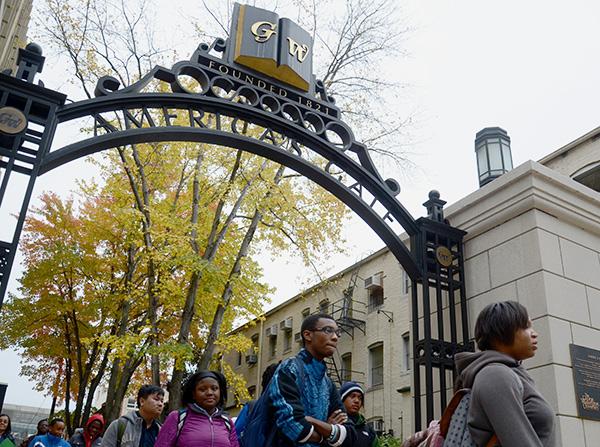When high school senior Ke’Asiah McLaughlin began narrowing down the colleges she would apply to, she had one main criterion: anywhere but D.C.
The 17-year-old Eastern Senior High School student was set on getting out of the city, but then her college counselor told her something that piqued her interest: GW offers a full ride to about seven D.C. high school students each year with the Stephen Joel Trachtenberg Scholarship.
GW might have had the Southeast-native’s attention, but she still wasn’t fully convinced. That changed when she visited campus with about 60 other students through Serve Your City, a nonprofit that links GW volunteers with local D.C. schools for help with college application and tours.
The group set up a campus visit for Eastern students, giving McLaughlin the chance to walk through Gelman Library, pop into a math class and chat with current students about the organizations they joined. After the tour, McLaughlin decided she would start her application to GW that night.
“At first, I was like, ‘I want to get away from home, I don’t want to be in D.C., I’ve been here all my life,’” McLaughlin said. “Now I’m here, and it’s a really good school. I felt something on the campus.”
As policymakers and advocates nationwide put a spotlight on affordability and diversity, there are more eyes than ever before watching the students least likely to make it to college – and more administrators are testing out ways to help them succeed. GW officials and several student groups have joined that push over the past year.
McLaughlin will have tough odds to beat coming from one of the worst public school systems in the country: 58 percent of D.C. public high school students graduate on time, one of the lowest rates in the country, according to a report from the Office of the State Superintendent of Education.
Catching a glimpse of campus
The event was Serve Your City’s first-ever Eastern High School College Day. GW sophomore Cory Shaffer, the recruitment chair of GW’s chapter, planned the event because “it’s important to remind students that college is attainable.”
“It’s one thing to hear about college. It’s another thing to come and see what’s it like,” Shaffer said.
Students met members of student organizations for a “speed-dating” lunch, in the hopes that as the Eastern High students spoke with members of the GW community, they would be able to envision themselves in a college setting.
Black Student Union President Kheri Freeman said they shared concerns and questions about how to tackle the application process, how to handle tough roommate relationships and what it’s like to be a minority on a predominantly white campus.
GW’s campus population is about 8.7 percent black, while 52.4 percent of students identify themselves as white, according to GW’s Office of Institutional Research and Planning.
“When they were walking around the campus, they were like, ‘There’s no one that looks like me,’” Freeman said. “It was important for us to let them know there are African-American students, and we do have an influence on the community, we do have an impact and are as successful as everyone else.”
GW reaches out
The University awards dozens of donor-funded scholarships each year, and the Stephen Joel Trachtenberg Scholarship is just one of them. In its 25 years, more than 150 D.C. residents have earned full rides to GW through the program.

The University met about 88 percent of financial aid need for incoming freshmen last fall. Though GW’s sticker price has grown to about $60,000 a year, the average cost of attendance is about half as much.
Increasingly, though, schools have focused on making sure the students are applying. When President Barack Obama invited 100 college leaders to the White House last year, he spoke about bringing more students from lower-income families into the higher education fold.
University President Steven Knapp was in attendance, and committed officials to helping D.C. students fill out financial aid forms and write essays, whether or not they apply to GW.
GW’s Senior Associate Provost for Enrollment Management Laurie Koehler said the admissions office has assigned each of its staffers to a D.C. high school to “even further develop those relationships.” Staff members went to Eastern Senior High School earlier this month to help students fill out college applications.
The University will also help send two high school admissions counselors to a national conference next fall, part of a larger social media challenge.
Where D.C. students are left behind
Serve Your City Founder Maurice Cook was working as an adviser in GW’s School of Business when he said he realized the University and its students spend too much energy on volunteer programs abroad instead of reaching out to nearby communities year-round. After seven years at GW, he opened the nonprofit’s D.C. headquarters.
“It’s sexier to serve abroad, but what students often don’t realize is that these places seven or so Metro stops away are often worlds apart,” Cook said.
The GW chapter has been run by students on campus since 2009. Cook said what sets his organization apart from groups like D.C. Reads and Jumpstart, which go out into the D.C. preschools and elementary schools to tutor students, is that his group focuses on high school in addition to primary schools.
He said there’s more than academics going into consideration when students apply to college, and that’s another area where D.C. students are left behind.
Cook said the organization has helped high school students learn rowing, tennis and competitive swimming so they can have a better chance at earning a sports scholarship. Minority students are typically underrepresented in those sports, he said, so scholarships associated with them are underutilized.
“The students don’t know their options, which often comes from a lack of exposure to options,” Cook said.








